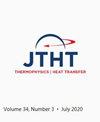考虑热辐射的超音速燃烧器自适应湍流涡模拟
IF 1.1
4区 工程技术
Q4 ENGINEERING, MECHANICAL
引用次数: 0
摘要
新开发的自适应湍流涡模拟(SATES)方法与三种湍流燃烧模型(即有限速率模型、涡流耗散模型和稳定层流小火焰模型)相结合,用于对德国航空航天中心(DLR)带楔形火焰支架的模型喷气燃烧器中的非预混合超音速氢气燃烧进行数值研究。研究调查了冲击波和流场的相互作用以及火焰结构。基于 SATES 的燃烧模拟结果与现有实验数据的一致性令人满意。研究还探讨了燃料喷射温度对燃烧过程的影响,发现氢气温度升高可提高燃烧效率。此外,还采用离散序数法/灰色气体加权和法考虑了热辐射效应。结果表明,热辐射传热降低了火焰温度,并对火焰形状和温度波动产生了显著影响。此外,辐射热通量也是一个重要因素,应纳入超音速燃烧模拟中。该研究证明了 SATES 方法在复杂超音速燃烧方面的潜力,同时也为超音速燃烧中的热辐射提供了参考。本文章由计算机程序翻译,如有差异,请以英文原文为准。
Self-Adaptive Turbulence Eddy Simulation of Supersonic Combustor Considering Thermal Radiation
The newly developed self-adaptive turbulence eddy simulation (SATES) method coupled with three turbulent combustion models, i.e., the finite-rate model, eddy-dissipation model, and steady laminar flamelet model, is used to numerically study the non-premixed supersonic hydrogen combustion in a DLR (German Aerospace Center) model scramjet combustor with a wedge flame holder. The study investigates the interactions of the shock waves and the flowfields as well as the flame structures. The SATES-based combustion simulation results demonstrate satisfactory agreement with the available experimental data. The study also explores the effect of fuel injection temperature on the combustion process and reveals that an increase in hydrogen temperature improves combustion efficiency. Additionally, thermal radiation effects are considered with the discrete ordinates method/weighted-sum-of-gray-gases method. The results indicate that thermal radiation heat transfer reduces the flame temperature and significantly affects the flame shape and temperature fluctuations. Also, radiation heat flux is an important factor and should be included in supersonic combustion simulations. The study demonstrates the potential of the SATES method for complex supersonic combustion and also provides a reference for thermal radiation in supersonic combustion.
求助全文
通过发布文献求助,成功后即可免费获取论文全文。
去求助
来源期刊

Journal of Thermophysics and Heat Transfer
工程技术-工程:机械
CiteScore
3.50
自引率
19.00%
发文量
95
审稿时长
3 months
期刊介绍:
This Journal is devoted to the advancement of the science and technology of thermophysics and heat transfer through the dissemination of original research papers disclosing new technical knowledge and exploratory developments and applications based on new knowledge. The Journal publishes qualified papers that deal with the properties and mechanisms involved in thermal energy transfer and storage in gases, liquids, and solids or combinations thereof. These studies include aerothermodynamics; conductive, convective, radiative, and multiphase modes of heat transfer; micro- and nano-scale heat transfer; nonintrusive diagnostics; numerical and experimental techniques; plasma excitation and flow interactions; thermal systems; and thermophysical properties. Papers that review recent research developments in any of the prior topics are also solicited.
 求助内容:
求助内容: 应助结果提醒方式:
应助结果提醒方式:


